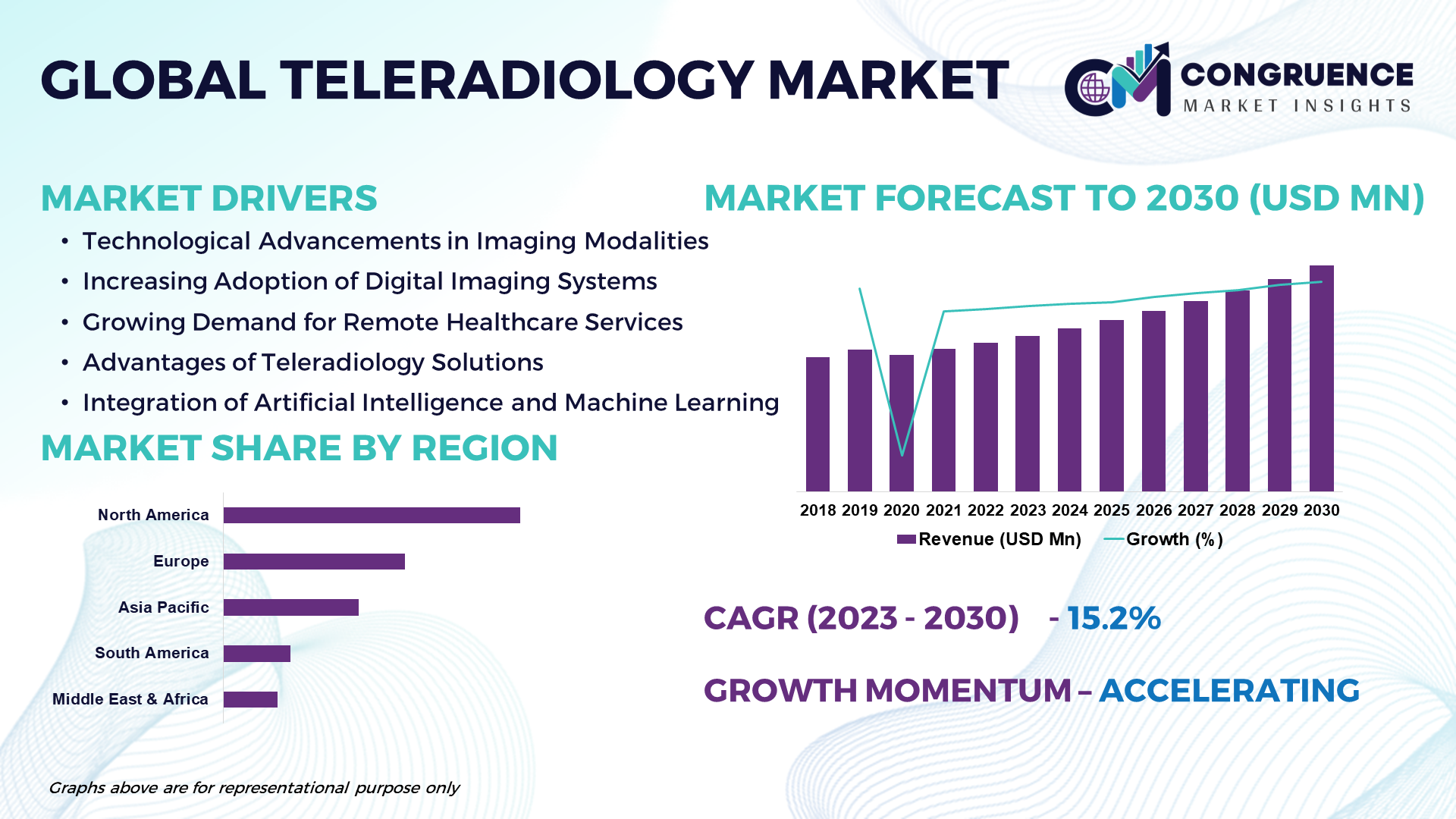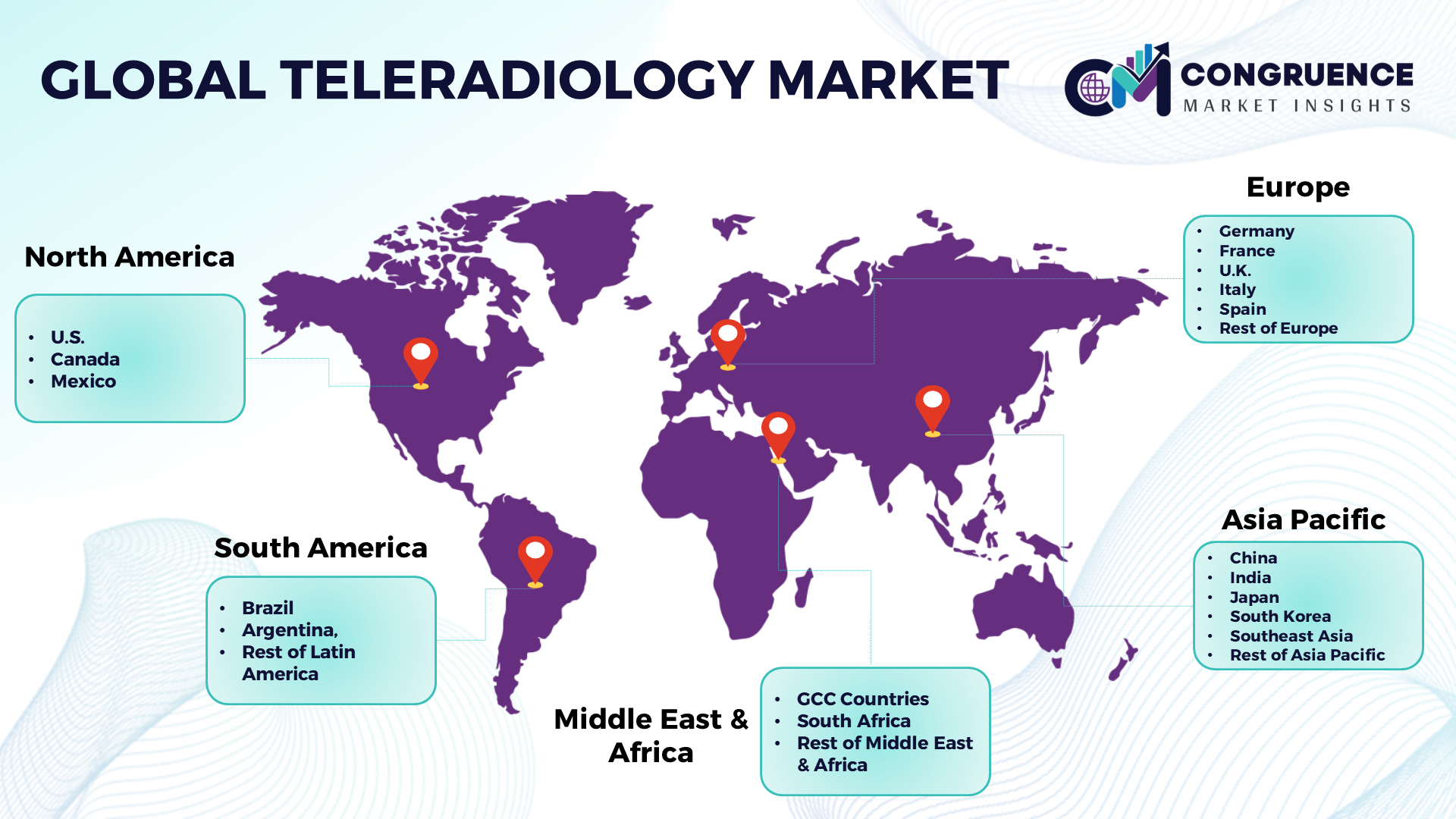Reports
The Global Teleradiology Market is projected to expand at a robust CAGR of 15.2% from 2023 to 2030, fueled by factors such as the growing demand for telemedicine solutions, the integration of artificial intelligence (AI) and machine learning (ML) technologies, and the emergence of cloud-based teleradiology platforms. Teleradiology is a telemedicine subspecialty that involves the transmission of radiological images, such as X-rays, CT scans, MRIs, and ultrasound images, from one location to another for interpretation and diagnosis. It enables remote access to radiology services, facilitates timely interpretation of imaging studies, and improves patient care outcomes. Teleradiology solutions encompass a range of hardware, software, and services designed to support image acquisition, transmission, storage, and interpretation across geographically dispersed healthcare facilities. The Teleradiology Market is experiencing rapid growth driven by factors such as technological advancements in imaging modalities, the increasing adoption of digital imaging systems, and the growing demand for remote healthcare services. Key drivers of market growth include the rising prevalence of chronic diseases, the expanding geriatric population, and the need for efficient diagnostic imaging solutions in underserved regions.

Teleradiology Market Major Driving Forces
Technological Advancements in Imaging Modalities: Ongoing advancements in imaging modalities, such as X-ray, CT, MRI, ultrasound, and nuclear imaging, are driving the development of more advanced and high-resolution radiological imaging systems, enabling more accurate and detailed diagnostic imaging studies and enhancing the capabilities of teleradiology solutions for remote image interpretation and diagnosis.
Increasing Adoption of Digital Imaging Systems: The increasing adoption of digital imaging systems, including digital X-ray, computed radiography (CR), digital radiography (DR), and picture archiving and communication systems (PACS), is driving the transition from traditional film-based radiology to digital imaging modalities, enabling seamless image acquisition, storage, retrieval, and transmission for teleradiology applications.
Growing Demand for Remote Healthcare Services: The growing demand for remote healthcare services, driven by factors such as the increasing prevalence of chronic diseases, the expanding geriatric population, and the need for accessible and convenient healthcare solutions in underserved regions, is fueling the adoption of teleradiology solutions for remote image interpretation, diagnosis, and consultation, driving market growth.
Advantages of Teleradiology Solutions: The advantages of teleradiology solutions, including improved access to radiology services, faster turnaround times for imaging studies, enhanced patient care outcomes, and reduced healthcare costs, are driving the adoption of teleradiology solutions by healthcare providers, imaging centers, and diagnostic laboratories, driving market expansion.
Integration of Artificial Intelligence and Machine Learning: The integration of artificial intelligence (AI) and machine learning (ML) technologies into teleradiology solutions for automated image analysis, computer-aided diagnosis (CAD), and clinical decision support is enhancing the capabilities of teleradiology platforms for image interpretation, diagnosis, and reporting, driving market growth and innovation.
Teleradiology Market Key Opportunities
Remote Patient Monitoring: The growing trend of remote patient monitoring and telehealth services presents opportunities for teleradiology providers to expand their service offerings to include remote interpretation of imaging studies for chronic disease management, post-operative care, and follow-up monitoring, enabling seamless coordination of care and improved patient outcomes.
Expansion into Underserved Regions: The expansion of teleradiology services into underserved regions and remote areas, including rural communities, developing countries, and areas with limited access to radiology specialists, presents opportunities for teleradiology providers to address unmet healthcare needs, improve access to diagnostic imaging services, and enhance patient care outcomes in underserved populations.
Teleconsultation Services: The integration of teleconsultation services into teleradiology platforms, enabling real-time communication and collaboration between radiologists, referring physicians, and healthcare providers for remote consultation, second opinions, and multidisciplinary case discussions, presents opportunities for teleradiology providers to enhance clinical decision-making, streamline care coordination, and improve patient management.
Mobile Teleradiology Solutions: The development of mobile teleradiology solutions, including smartphone-based imaging apps, portable imaging devices, and cloud-based teleradiology platforms, presents opportunities for teleradiology providers to offer on-the-go image interpretation and consultation services, enabling flexible and convenient access to radiology expertise anytime, anywhere, and enhancing the efficiency and accessibility of teleradiology services.
Integration with Electronic Health Records: The integration of teleradiology solutions with electronic health records (EHR) systems and health information exchange (HIE) networks, enabling seamless interoperability and data exchange between teleradiology platforms and healthcare IT systems, presents opportunities for teleradiology providers to streamline workflow integration, improve data management, and enhance the continuity of care for patients across healthcare settings.
Teleradiology Market Key Trends
· Cloud-Based Teleradiology Platforms: The growing adoption of cloud-based teleradiology platforms for image storage, sharing, and collaboration, enabling remote access to radiology studies, real-time image interpretation, and secure data exchange between healthcare facilities, is driving the trend towards cloud-based teleradiology solutions for enhanced scalability, flexibility, and accessibility of radiology services.
· Artificial Intelligence in Teleradiology: The integration of artificial intelligence (AI) and machine learning (ML) algorithms into teleradiology platforms for automated image analysis, pattern recognition, and computer-aided diagnosis (CAD), enabling faster and more accurate interpretation of radiological images, is driving the adoption of AI-driven teleradiology solutions for improved clinical decision-making and workflow efficiency.
· Telemedicine Integration: The integration of teleradiology solutions with telemedicine platforms and remote patient monitoring systems, enabling seamless coordination of care, remote consultation, and virtual visits between radiologists, referring physicians, and patients, is driving the trend towards integrated telemedicine and teleradiology solutions for comprehensive remote healthcare delivery and patient management.
· Mobile Teleradiology Applications: The development of mobile teleradiology applications, including smartphone-based imaging apps and tablet-based image viewing platforms, enabling radiologists to access, interpret, and report radiological images remotely from mobile devices, is driving the adoption of mobile teleradiology solutions for on-the-go image interpretation, consultation, and decision-making, enhancing the flexibility and accessibility of teleradiology services.
· Subspecialty Teleradiology Services: The provision of subspecialty teleradiology services, including musculoskeletal imaging, neuroradiology, cardiovascular imaging, and pediatric radiology, by specialized radiologists and expert imaging centers, is driving the trend towards subspecialty-focused teleradiology solutions for more accurate and specialized interpretation of complex imaging studies and improved patient care outcomes.

Market Competition Landscape
The global teleradiology Market is characterized by intense competition among a diverse range of market players offering a wide array of hardware, software, and services for teleradiology applications across various healthcare settings. Prominent players in the Teleradiology Market include:
· Agfa-Gevaert Group
· Siemens Healthineers AG
· Fujifilm Holdings Corporation
· Koninklijke Philips N.V.
· GE Healthcare
· Carestream Health, Inc.
· Merge Healthcare Solutions, Inc.
· Teleradiology Solutions
· vRad (Virtual Radiologic)
· USARAD Holdings, Inc.
These companies offer a comprehensive portfolio of teleradiology solutions, including hardware systems (such as digital X-ray systems, CT scanners, and MRI machines), software platforms (such as PACS, RIS, and teleradiology software), and professional services (such as remote image interpretation, consultation, and reporting) to cater to the diverse needs of healthcare providers, imaging centers, and diagnostic laboratories.
|
Report Attribute/Metric |
Details |
|
Base Year |
2022 |
|
Forecast Period |
2023 – 2030 |
|
Historical Data |
2018 to 2022 |
|
Forecast Unit |
Value (US$ Mn) |
|
Key Report Deliverable |
Revenue Forecast, Growth Trends, Market Dynamics, Segmental Overview, Regional and Country-wise Analysis, Competition Landscape |
|
Segments Covered |
· By Product Type (Hardware, Software, Services) · By Modality (X-ray, CT, MRI, Ultrasound, Nuclear Imaging) · By End-user (Hospitals, Diagnostic Imaging Centers, Ambulatory Surgical Centers) |
|
Geographies Covered |
North America: U.S., Canada and Mexico Europe: Germany, France, U.K., Italy, Spain, and Rest of Europe Asia Pacific: China, India, Japan, South Korea, Southeast Asia, and Rest of Asia Pacific South America: Brazil, Argentina, and Rest of Latin America Middle East & Africa: GCC Countries, South Africa, and Rest of Middle East & Africa |
|
Key Players Analyzed |
Agfa-Gevaert Group, Siemens Healthineers AG, Fujifilm Holdings Corporation, Koninklijke Philips N.V., GE Healthcare, Carestream Health, Inc., Merge Healthcare Solutions, Inc., Teleradiology Solutions, vRad (Virtual Radiologic), and USARAD Holdings, Inc. |
|
Customization & Pricing |
Available on Request (10% Customization is Free) |
